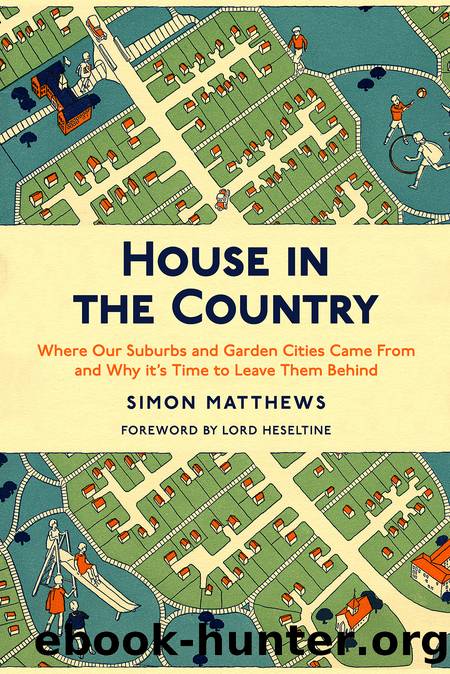House in the Country by Simon Matthews

Author:Simon Matthews
Language: eng
Format: epub
Published: 2022-05-04T08:36:52+00:00
7. Given his pedigree and involvement throughout his life with Portmeirion, Williams-Ellis might have seemed an odd choice: but in the 1930s he had supported modern architecture in his book Architecture Here and Now (1934, with John Summerson), and given Bevanâs views about modern villages may have seemed a perfect match.
8. For a full discussion of Silkinâs difficulties at Stevenage see https://core.ac.uk/download/pdf/220156737.pdf and also Austerity Britain 1945-1951 Kynaston p161-162.
9. In 1931 the LCC elected 83 Conservative, 35 Labour and 6 Liberal councillors. This changed in 1934 to 69 Labour and 55 Conservative. By 1937, it was 75 Labour and 49 Conservative and in 1946 it was 90 Labour, 30 Conservative, 2 Liberal and 2 Communist. It was commonly believed that Morrison pursued the construction of large municipal housing estates in areas with Conservative representation to tilt these locations electorally toward the Labour Party. There is no proof of this and the statement ascribed to Morrison (that he would âbuild the Tories out of Londonâ) appears to be an urban myth. No evidence of it can be found prior to the 1960s: it appeared at the time the Conservative Party were replacing the LCC with the GLC. An example of this quote being attributed to Morrison is Leo McKinstry, âLabour is stealing your countryâ, The Spectator, 24 July 2004, p. 20. In fact, although Morrisonâs LCC built substantial numbers of homes, a large number were outside the County of London entirely.
10. Felton represented St Pancras SW on the LCC, 1937-1946. After this she was chair of Peterlee New Town Corporation, where she was the subject of scurrilous rumours about her relationships with male staff. Her visit to North Korea, which was followed by her broadcasting to the UK from Moscow, was debated in the House of Commons on 14 June 1951, with calls from the Conservative ranks that she be charged with high treason (which carried the death penalty). See: https://api.parliament.uk/historic-hansard/commons/1951/jun/14/mrs-felton-visit-to-korea The tone of the debate, with much innuendo and doubt about her qualifications (she had a PhD from the London School of Economics), was deeply sexist.
11. Although prepared to let most of the new town proposals proceed when they returned to power in 1951, the Conservatives did abandon one of the schemes, at Mobberley, Cheshire after opposition from local MP Lt Col Walter Bromley-Davenport MP. For some of the exchanges on this see: https://api.parliament.uk/historic-hansard/commons/1949/jun/28/new-town-mobberley
12. Lubetkinâs background is the subject of some debate. From Georgia, it appears that he fought in the Red Army during the Russian Civil War, after which he studied and worked in Berlin and Paris. The birth certificate that he produced to gain entry to the UK appears to have been a forgery, designed to obscure his Red Army service. For more on his design for Spa Green Estate see: https://www.locallocalhistory.co.uk/municipal-housing/spa-green/index.htm
13. See Austerity Britain 1945-1951 Kynaston p332 for more in this vein, from Osborn, and others. Osborn was involved in increasingly bitter disputes with both the RIBA and the LCC and by 1950 had fallen out with Mumford over density levels.
Download
This site does not store any files on its server. We only index and link to content provided by other sites. Please contact the content providers to delete copyright contents if any and email us, we'll remove relevant links or contents immediately.
Kathy Andrews Collection by Kathy Andrews(11677)
The remains of the day by Kazuo Ishiguro(8739)
Paper Towns by Green John(5022)
Spare by Prince Harry The Duke of Sussex(4995)
The Body: A Guide for Occupants by Bill Bryson(4886)
Industrial Automation from Scratch: A hands-on guide to using sensors, actuators, PLCs, HMIs, and SCADA to automate industrial processes by Olushola Akande(4845)
Machine Learning at Scale with H2O by Gregory Keys | David Whiting(3968)
Be in a Treehouse by Pete Nelson(3875)
Harry Potter and the Goblet Of Fire by J.K. Rowling(3737)
Never by Ken Follett(3703)
Goodbye Paradise(3666)
Into Thin Air by Jon Krakauer(3261)
The Remains of the Day by Kazuo Ishiguro(3254)
The Cellar by Natasha Preston(3219)
The Genius of Japanese Carpentry by Azby Brown(3189)
Fairy Tale by Stephen King(3156)
120 Days of Sodom by Marquis de Sade(3117)
Drawing Shortcuts: Developing Quick Drawing Skills Using Today's Technology by Leggitt Jim(2960)
The Man Who Died Twice by Richard Osman(2954)
